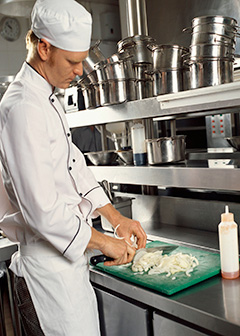Summary

| Quick Facts: Food Preparation Workers | |
|---|---|
|
$19,100 per year
$9.18 per hour |
|
| Less than high school | |
| None | |
| Short-term on-the-job training | |
| 813,700 | |
| 10% (About as fast as average) | |
| 84,100 | |
What Food Preparation Workers Do
Food preparation workers perform many routine tasks under the guidance of cooks or food supervisors. They prepare cold foods, slice meat, peel and cut vegetables, brew coffee or tea, and do many other tasks.
Work Environment
Food preparation workers are employed in restaurants, hotels, and other places where food is served, such as grocery stores, schools, hospitals, and cafeterias. They often work early mornings, late evenings, weekends, or holidays. The majority work part time.
How to Become a Food Preparation Worker
Short-term on-the-job training is the most common way to learn the skills necessary for food preparation workers. No formal education or previous work experience is required.
Pay
The median hourly wage of food preparation workers was $9.18 in May 2010.
Job Outlook
Employment of food preparation workers is projected to grow 10 percent from 2010 to 2020, about as fast as the average for all occupations. Job opportunities are expected to be good because of the need to replace the large number of workers who leave the occupation each year.
Similar Occupations
Compare the job duties, education, job growth, and pay of food preparation workers with similar occupations.
O*NET
O*NET provides comprehensive information on key characteristics of workers and occupations.
Contacts for More Information
Learn more about food preparation workers by contacting these additional resources.








